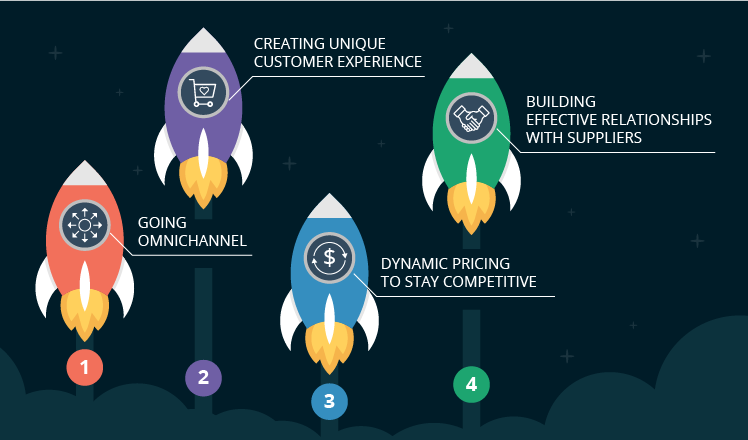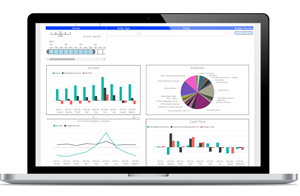The Christmas season is over, and you’ve heroically lived through it. The beginning of the year is a great time to look around and check the latest retail trends. We’ve scanned the expectations and selected the ideas that are likely to add value. The compilation has another unifier: all the initiatives should be supported with data analytics. Let’s have a close look at the four chosen trends.

1. Going omnichannel
Retail started to move beyond brick-and-mortar stores long ago. However, many retailers still consider making the first step in this direction. If you are among those, you need a proper retail data analytics solution.
Let’s say, a consumer electronics retailer runs both physical stores and an online one. The retailer’s brick-and-mortar stores are showing brilliant sales, while their online store is terribly lagging behind. Naturally, the retailer is not happy with the format that does not bring sales. However, is their e-store really useless, and they are just wasting money to keep it running?
After scrutinizing customer big data for both channels, the retailer may find out the following: 75% of website visitors are surfing the online catalog to compare product features and finish their purchases in one of the physical stores. In this case, if the retailer abandons an online store, they may also lose the majority of customers who would prefer shopping with another retailer in a way that they find convenient.
2. Creating unique customer experience
Customers make purchases in brick-and-mortar and online stores, take part in loyalty programs, create shopping lists and place orders in the apps. In a word, they interact with a retailer in different ways and expect them to offer a personalized approach in return. As a retailer, you must understand how precious customer data is, so you should be striving to repay your customers with targeted marketing campaigns and product offers.
Let’s assume, you are a drugstore retailer. You collect and analyze customer data to understand their behavior and preferences. Your analytical system knows that Customer A used to visit your store once a month to buy 3 packs of nappies, a washing powder of brand X and a dishwashing liquid of brand Y. But this month, Customer A didn’t appear. To encourage him or her to visit your store, you may then send them a 5% coupon for their favorite washing powder brand.
As a real-life example of data analytics in action, we’ve chosen Nordstrom with their initiative Reserve Online & Try In Store. Their app users can select items and book them for trying on in a particular store and at a convenient time. Nordstrom has gone further: the retailer can recognize if a customer is passing by their store and kindly invite them to come in. How can anyone stay indifferent when they receive the message: Hello from Nordstrom. It looks like you are nearby, and your item is ready to try! To crown it all, once a customer is in the store, he or she will find their name on the door of a fitting room. Here is the personalized approach in action.
3. Dynamic pricing to stay competitive
Once competitive intelligence was a challenge for brick-and-mortar retailers. Naturally, the rivals were unwilling to share any information, and price monitoring at the competitor’s stores was time-consuming, prone to mistakes and exhausting. In the era of ecommerce, retailers can benefit from new approaches to competitive intelligence. By definition, online stores are publicly available, and a lot of information such as product details, promo offers, prices and category hierarchy is always at hand. This all made dynamic pricing possible, when the system is able to scan competitors’ prices in real time, run a complex analysis very quickly and change a retailer’s prices automatically based on the defined rules. Now, if an ecommerce retailer wants to be 5% cheaper than their competitors are, with big data analytics they are able to do this.
Brick-and-mortar retailers can also rely on big data analytics, though some time ago they experienced some implementation limitations, as store employees had to replace price tags manually, which was time-consuming. With the invention of electronic price tags, dynamic pricing has become available to brick-and-mortar retailers, too. In no time, the system can change prices based on analyzing the sales, stock, competitors’ prices, customer demand, shelf life, etc.
4. Building effective relationships with suppliers
An industry benchmark, Walmart laid the rules on how to collaborate with the suppliers. And this policy can add $1 billion to Walmart’s revenue. The retailer has implemented a scoring system to assess the suppliers according to On-Time, In-Full principle. In simple words, either delivery is late or early, the supplier should pay a fine. The same scenario works if the supplier delivers timely, but the quantity of goods is wrong, their quality is poor, or packaging is damaged.
If you are to follow Walmart’s best practice, you can also think about tuning your data analytics system to differentiate between strategic and non-strategic suppliers, critical and non-critical product categories. Additionally, you can set different thresholds. For instance, the critical number of troublesome deliveries may be 10%.
With such a scoring system, a retailer will easily identify whether a supplier is reliable or not. Besides, this approach will contribute to a more efficient inventory management. So, a retailer’s persistent headache caused by over-stocks and out-of-stocks should finally subside.
To sum it up
Retailers’ aspirations don’t change significantly with the time. Satisfying customer needs better, outperforming competitors and building up effective relationships with suppliers are at the top of every retailer’s wish list. Despite the retail industry is constantly developing and there appear new sophisticated ways to solve daily and strategic challenges, this does not guarantee that every retailer reaches the desired result. However, supporting the initiatives with data analytics can make the difference.

Are you striving for informed decision-making? We will convert your historical and real-time data into actionable insights and set up forecasting.

